Can You Freeze Plantain
You can freeze plantains at various stages of ripeness, but semi-ripe plantains yield the best results, as they retain their texture and flavor after thawing. When choosing plantains for freezing, look for those with slightly yellow or green skin and a bit of give when pressed. Avoid overripe or green plantains, as they can become mushy or starchy. To freeze, peel and cut the plantains, removing any brown spots, then transfer them to an airtight container or freezer bag. Partially defrosting them later makes them easy to fry, and by following these steps, you'll be able to get the most out of your frozen plantains.
This post may contain affiliate links. If you make a purchase through these links, I may earn a commission at no additional cost to you. Additionally, portions of this post may be generated using artificial intelligence (AI) technology. While we strive for accuracy, please be aware that AI-generated content may not always be perfect and should be fact-checked when necessary.
The Spatula Scoops
- Semi-ripe plantains are ideal for freezing, as they won't become mushy when thawed.
- Green plantains can be too starchy, while overripe ones lose texture when frozen.
- Wash, peel, and cut plantains into desired sizes before freezing to maintain texture and flavor.
- Store frozen plantains in airtight containers or freezer-safe bags to prevent freezer burn and preserve quality.
- Frozen plantains can be stored for up to 3 months and used in various dishes with proper defrosting and cooking methods.
Choosing the Right Plantains

When it comes to freezing plantains, you're looking for the perfect candidates. These should be semi-ripe plantains, as overripe ones are not suitable for freezing. Make sure the plantains still look fresh and haven't started to decay. A semi-ripe plantain will be slightly yellow or green, with a little bit of give when you press on it. Like corn, plantains have diverse uses in various culinary applications, making them a versatile ingredient to keep on hand. Proper selection and storage can help maintain their nutritional value and flavor.
Avoid choosing plantains that are too ripe, as they'll become mushy and soft when thawed. The skin might also start to wrinkle and turn brown, which is a sign of over-ripeness. On the other hand, green plantains can be too starchy and may not retain their flavor and texture when frozen.
When selecting plantains, also look for any visible signs of damage or decay. Check for bruises, cuts, or soft spots on the skin, and avoid plantains with mold or fungus growth. Choose plantains that are firm and have a smooth, even skin. These will be the best candidates for freezing and will help you preserve their flavor and texture.
Preparing Plantains for Freezing

Now that you've selected the perfect semi-ripe plantains, it's time to prepare them for freezing. Start by washing the plantains thoroughly to remove dirt and bacteria. You'll want to peel the plantains and cut them into your desired size. Some popular ways to cut plantains include:
| Cutting Method | Description | Best Use |
|---|---|---|
| Sliced | Thinly slice the plantains | Frying or baking |
| Diced | Cut the plantains into small cubes | Adding to dishes or salads |
| Wedges | Cut the plantains into wedges | Frying or roasting |
| Chunks | Cut the plantains into larger chunks | Frying or boiling |
When cutting the plantains, make sure to remove any brown or bruised spots. This will help maintain the plantain's texture and flavor when you're ready to use them. Thank you so much for taking the time to properly prepare your plantains – it'll make a big difference in the long run. After cutting, transfer the plantain pieces into a Ziploc bag or an airtight container to prepare them for freezing.
Freezing and Storage Tips
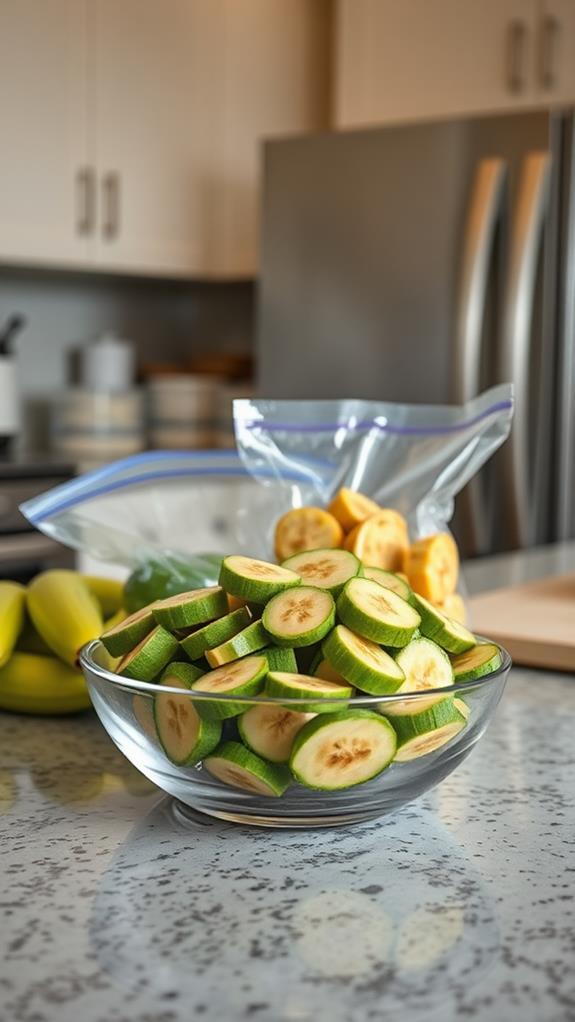
As you prepare to store your frozen plantains, it is critical to follow some key freezer storage tips and proper freezing techniques to maintain their quality. You'll want to guarantee a consistent power supply to your freezer, as this will help prevent temperature fluctuations that can affect the texture and appearance of your plantains. Using silicone freezer molds with convenient fill lines can help you portion and organize your frozen plantains efficiently, reducing waste and simplifying meal prep. By freezing your plantains correctly, you can enjoy them for 1-3 months and use them in a variety of dishes.
Freezer Storage Tips
By arranging cut plantain pieces in a single layer within a Ziploc bag, you can effectively prevent sticking and maintain their fresh appearance during freezer storage. This simple step guarantees that your frozen plantains remain in the best possible condition for a longer period.
When storing frozen plantains, it's crucial to take the following into account:
- Maintain a consistent freezer temperature: Ensure your freezer maintains a consistent temperature, ideally below 0°C, to preserve the plantain's texture and flavor.
- Label the storage bag: Label the storage bag with the date and contents, making it easier to keep track of how long the plantains have been stored.
- Store in airtight containers: Transfer the frozen plantains to airtight containers or freezer-safe bags to prevent freezer burn and maintain freshness.
- Consume within 1-3 months: Frozen plantains can be stored for 1-3 months, after which their quality may degrade. Make sure to consume them within this time frame for the best results.
Proper Freezing Techniques
Freezing plantains can be a great way to preserve them for future meals, but it is vital to do it correctly to maintain their texture and flavor. To start, you'll want to wash and peel the plantains, then cut them into your desired shapes. Arrange them in a single layer in a Ziploc bag to prevent sticking during freezing. This simple step will save you a lot of hassle when you're ready to use them.
When storing your frozen plantains, make sure they're in a well-functioning freezer at a consistent temperature. This will help them last for 1-3 months. Partially defrosting the frozen plantains makes frying them easier while maintaining their fresh appearance and texture. You can use these fried frozen plantains in various dishes, providing a quick and convenient ingredient without compromising quality.
How to Defrost Frozen Plantains
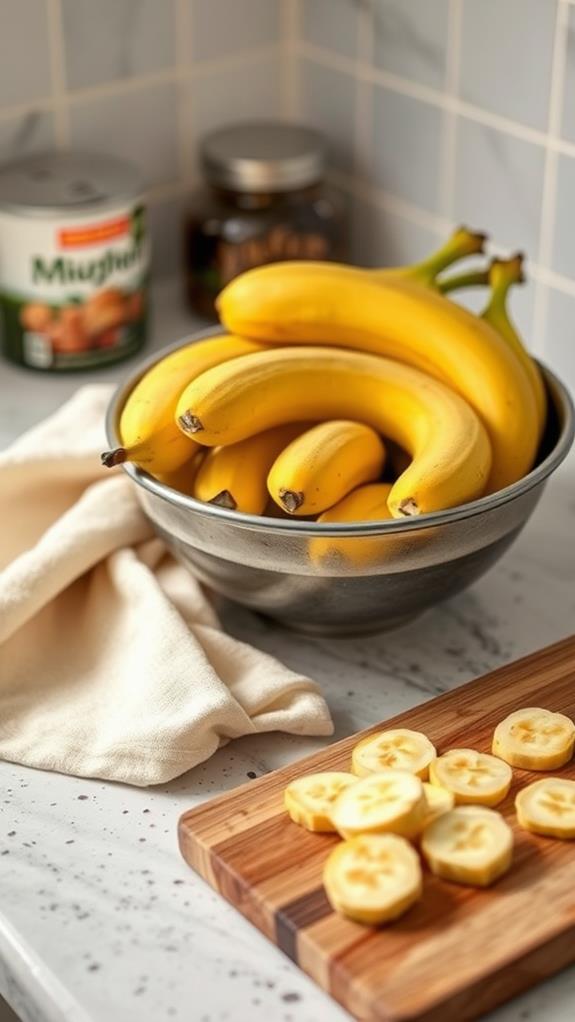
You've stored your plantains in the freezer, and now it's time to defrost them for your next meal. The defrosting process is vital in maintaining the plantain's texture and appearance. To achieve this, you'll want to partially defrost the plantain, rather than thawing it completely. This method guarantees the plantain maintains its fresh appearance, strength, and texture. For efficient meal prep and portioning, consider using silicone freezer molds to store individual servings of plantain-based dishes.
The defrosting time will depend on how long the plantain has been stored in the freezer. Here's what you need to know about partially defrosting frozen plantains:
- *Speed up the process*: Remove the desired number of frozen plantains from the freezer and place them in room temperature or in cold water to speed up the defrosting process.
- *Check the texture*: Partially defrosted plantain should still have some firmness to it. This texture is ideal for cooking.
- *Don't over-defrost*: Avoid completely thawing the plantain, as this can lead to a loss of texture and structure.
- *Use as desired*: Once partially defrosted, you can use the plantain in various dishes, including breakfast and lunch.
Cooking Frozen Plantains
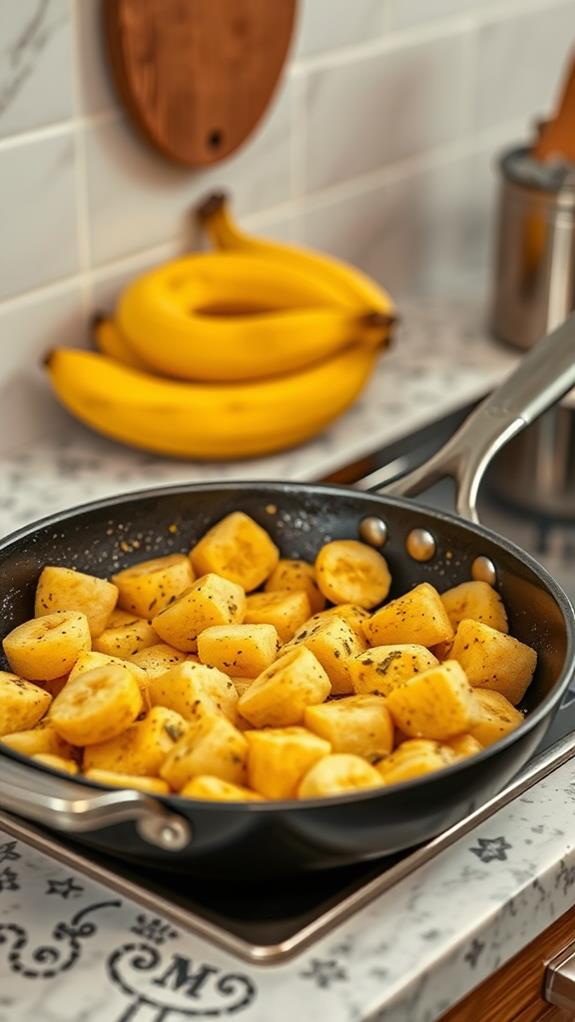
You're ready to start cooking with your frozen plantains, and there are several methods to achieve delicious results. When cooking frozen plantains, you can try the partial defrosting method, or you can pan-fry or air-fry them straight from the freezer for a crispy exterior. By exploring these cooking methods, you'll be able to create a variety of tasty dishes with your frozen plantains.
Partial Defrosting Method
Defrosting partially can be a game-changer when it comes to cooking frozen plantains. By defrosting them partially, you can easily fry them while maintaining their fresh appearance and retaining their strength and texture. The defrosting time required will depend on the duration the plantains have been stored in the freezer, so be sure to check on them regularly.
When using the partial defrosting method, you can enjoy the following benefits:
- Easy frying: Partially defrosted plantains can be fried without the need for additional liquid, as they fry well on their own.
- Convenient meal prep: Partially defrosting frozen plantains is a convenient way to have a ready-to-use ingredient that saves time in meal preparation.
- Versatile dishes: Fried partially defrosted plantains can be used in various dishes and served for breakfast or lunch.
- Time-saving: Partial defrosting helps you skip the extra steps of boiling or cooking plantains from a completely frozen state.
Frying Frozen Plantains
Frying frozen plantains offers a convenient alternative to partial defrosting, allowing you to achieve a crispy exterior and a soft interior without the need for prior thawing. This method is perfect for when you're short on time or want to minimize food waste. When frying frozen plantains, you'll need to adjust the cooking time and temperature to guarantee they're cooked thoroughly and don't overcook.
Here's a comparison of frying fresh and frozen plantains:
| Characteristic | Fresh Plantains | Frozen Plantains |
|---|---|---|
| Texture | Soft, starchy | Soft, slightly firmer |
| Taste | Sweet, earthy | Sweet, slightly blander |
| Frying Time | 2-3 minutes per side | 3-4 minutes per side |
Keep in mind that the texture and taste of fried frozen plantains are comparable to fresh plantains, making them a practical substitute. You can incorporate them into various dishes, such as side dishes, breakfast items, or plantain-based snacks. Simply adjust the cooking time and temperature, and you're good to go.
Cooking Methods
The versatility of frozen plantains allows for various cooking methods beyond frying, and some may even rival their fresh counterparts with respect to taste and texture. When cooking frozen plantains, you can try different techniques to achieve the desired flavor and texture. Here are some methods you can try:
- Baking: You can bake frozen plantains in the oven with a drizzle of oil, salt, and any other seasonings you like. This method is great for making plantain chips or sweet plantains.
- Boiling: Boiling frozen plantains is a simple way to cook them without adding extra fat. Just place them in a pot of boiling water, and let them cook until they're tender.
- Grilling: Grilling frozen plantains gives them a nice smoky flavor and a tender texture. You can brush them with oil and grill them until they're caramelized.
- Roasting: Roasting frozen plantains in the oven brings out their natural sweetness. Simply slice them, toss them with oil and spices, and roast them in the oven until they're tender.
When cooking frozen plantains, you can experiment with different seasonings and spices to add flavor. Just be sure to adjust the cooking time and temperature according to the method you choose.
Benefits of Freezing Plantains
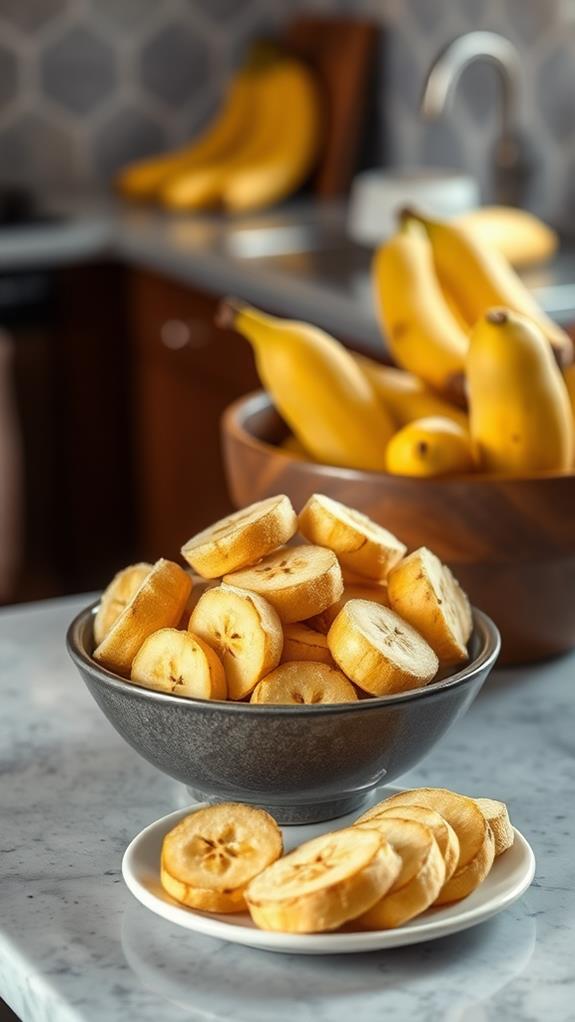
Freezing plantains opens up numerous possibilities for home cooks and meal planners. For one, you can store them for up to 3 months, maintaining their freshness and availability throughout. This extended shelf life means you can buy plantains in bulk and use them as needed, reducing the risk of spoilage and minimizing food waste. When you freeze plantains, they retain their texture and flavor, making them suitable for various dishes, from savory stews to sweet desserts.
Freezing also simplifies meal preparation. Partially defrosting frozen plantains makes them easier to fry, guaranteeing consistent results with minimal effort. Additionally, frozen plantains offer a ready-to-use ingredient that saves time during meal prep. By having a convenient, pre-prepared ingredient on hand, you can streamline your cooking process and spend more time on other activities.
In households with children, freezing plantains is particularly beneficial. It helps reduce food waste by providing a way to preserve excess produce and assures a steady supply of nutritious food. Overall, freezing plantains offers numerous benefits that can enhance your cooking experience and make meal planning more efficient.
Plantain Preservation Best Practices
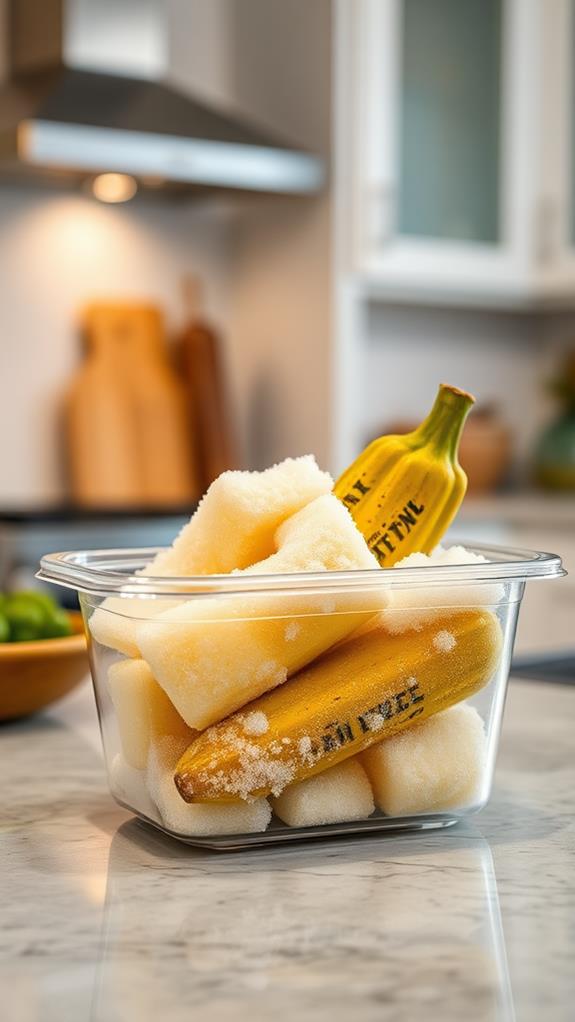
When preserving plantains, you'll want to follow a few best practices to guarantee they retain their flavor, texture, and freshness. Proper storage is key to enjoying your frozen plantains for a longer period. To achieve this, consider the following tips:
- Store in airtight containers: Transfer cut plantain into a Ziploc bag, making sure the pieces aren't sticking together. This will prevent them from freezing in a clump.
- Maintain freezer consistency: Ascertain your freezer is functioning properly and maintains a consistent power supply. This will help prevent fluctuations in temperature that can affect the plantain's quality.
- Partially defrost for frying: When you're ready to use your frozen plantain, partially defrost it. This will make frying easier while maintaining its fresh appearance and texture.
- Freeze without added liquid: You don't need to add any liquid to your plantain before freezing. Simply place it in the freezer, and it'll be ready to use when you need it.
Using Frozen Plantains in Recipes
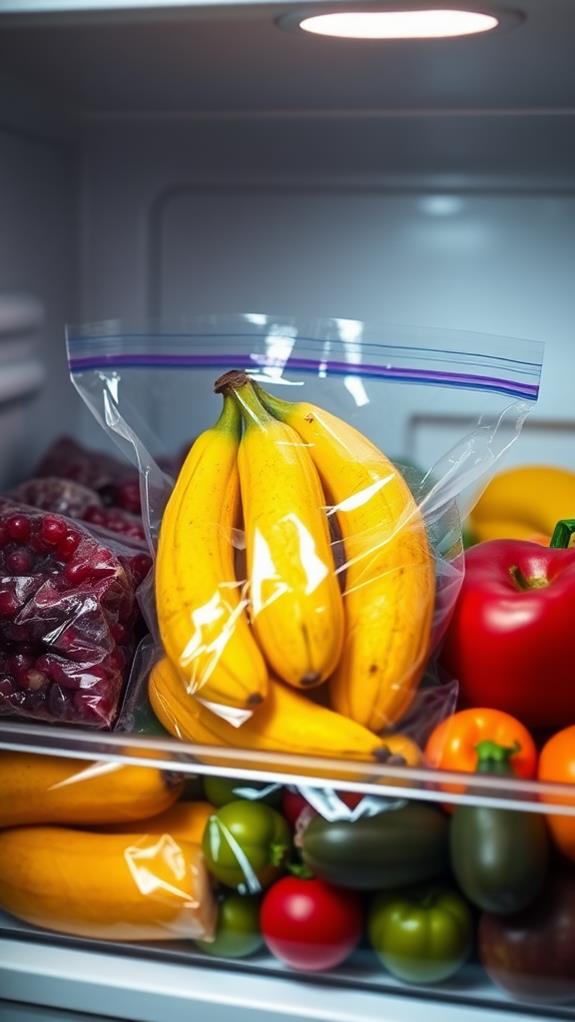
One of the most significant advantages of freezing plantains is their versatility in various recipes. When you're ready to use them, simply defrost the plantains and incorporate them into your favorite dishes. You can pan-fry, bake, or mash defrosted frozen plantains to create a range of flavorful plantain-based dishes. This makes them a convenient ingredient for quick meal preparation, as they maintain their texture and flavor well.
Incorporating frozen plantains into your recipes can add a unique starchy and slightly sweet element to both savory and sweet dishes. They can be used in a variety of recipes, from mashed plantain dishes to plantain-based snacks and sides. By using frozen plantains, you can reduce food waste and have access to this ingredient year-round. This is especially beneficial for regions where plantains are not readily available. Additionally, frozen plantains can be a game-changer for meal prep, as they can be easily incorporated into a variety of dishes, such as soups, stews, and casseroles. Experiment with different recipes to find your favorite ways to use frozen plantains.
Frequently Asked Questions
How Do You Freeze Fresh Plantains?
When it comes to preserving plantains, you'll want to freeze them at the right stage of ripeness. Choose plantains that are ripe but still firm, then cut them into desired shapes. Transfer the pieces to a Ziploc bag, arranging them to prevent sticking. Make sure to label the bag and store it in a well-functioning freezer to keep the plantains fresh for 1-3 months.
What to Do With Frozen Plantains?
You've got frozen plantains and you're not sure what to do with them. You can use them to make mashed plantains, plantain chips, or add them to stews and curries for a starchy and flavorful component. Pan-fry thawed frozen plantains until golden brown and crispy for a delicious side dish or snack. You can also blend them into smoothies, milkshakes, or baked goods like breads and muffins for added flavor and nutrition.
Do Frozen Plantains Go Bad?
You're probably wondering if those frozen plantains you stored a while back are still good to eat. Generally, frozen foods can last for a year or more, but the key factor is consistent freezer temperature. In the case of plantains, they can last 1-3 months in a well-functioning freezer. If you've stored them properly, they'll maintain their appearance and texture when partially defrosted, making them perfect for frying or cooking.
How Do You Store Leftover Plantains?
To store leftover plantains, you'll want to transfer them to a Ziploc bag or airtight container. Arrange the plantains to avoid sticking, making it easier to separate them later. Place the bag or container in a well-functioning freezer to maintain a consistent temperature. This method allows you to keep leftover plantains for 1-3 months, making meal prep more efficient and reducing food waste.
Conclusion
Now that you've learned the ins and outs of freezing plantains, you can preserve these versatile fruits and access a world of culinary possibilities. Imagine having a stash of perfectly ripened plantains at your fingertips, ready to be transformed into crispy tostones, sweet maduros, or hearty soups. By freezing plantains, you're not only saving time but also reducing food waste and expanding your recipe repertoire. Enjoy experimenting with your frozen plantain stash.





